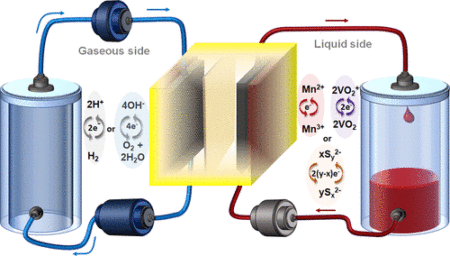Jan
26
Grid Storage Batteries For 1/5 The Price
January 26, 2021 | Leave a Comment
University of Warwick researchers in collaboration with Imperial College London, have found a way to enhance hybrid flow batteries and their commercial use. The new approach can store electricity in these batteries for very long durations for about a fifth the price of current technologies, with minimal location restraints and zero emissions.
The researchers’ enhanced three hybrid flow cells use nitrogen doped graphene (exposed to nitrogen plasma) in a binder-free electrophoresis technique (EPD).
Wind and solar power are increasingly popular sources for renewable energy. Unfortunately, intermittency issues keep them from connecting widely to the National grid. One potential solution to this problem involves in the deployment of long-duration battery technology, such as the redox flow battery. Despite its great promise the current costs of this system are a key determining factor to real-world adoption. An affordable grid battery should cost £75/kWh, ($102.60) according to the US Department of Energy. Lithium-ion batteries, which lead the charge for grid storage, cost about £130/kWh ($177.80).

A Binder-Free Horizontal Electrophoretic Deposition (EPD) Process Is Used to Activate Commercial Carbon Paper Electrodes Using Nitrogen-Doped Graphenea. These modified electrodes are employed in three types of hybrid redox flow cells (HRFC), namely hydrogen/vanadium (RHVFC), hydrogen/manganese (RHMnFC), and polysulfide/air (S-Air). A typical HRFC consists of an electrochemical cell, storage tank, and hydrogen or oxygen gas cylinder. The anolyte and catholyte are separated by a nafion proton-exchange membrane (in the S-Air cell, the membrane used is similar to sodium ion exchange), respectively. Image Credit: WMG at the University of Warwick. Click image for the largest view.
The new enhanced hybrid flow batteries or regenerative fuel cell (RFC) technology adds flexibility in siting and with minimal environmental impact. The technology combines carbon-based electrodes with economically sourced electrolytes, (manganese or sulfur, which are abundant chemicals in the planet) by means of a simple and yet highly effective electrophoretic deposition of nano-carbon additives (nitrogen-doped graphene) that enhance the electrode durability and performance significantly in highly acidic or alkaline environments.
Dr Barun Chakrabarti, a Research Fellow in WMG at the University of Warwick and one of the lead authors on the paper said, “This EPD technique is not only simple but also improves the efficiencies of three different economical hybrid flow batteries thereby increasing their potential for widespread commercial adoption for grid-scale energy storage.”
The hybrid flow battery’s total chemical cost is about 1/30th the cost of competing batteries, such as lithium-ion systems. Scaled-up technologies may be used to store electricity from wind or solar power, for multiple days to entire seasons, for about £15 ($20.52) to £20 ($27.35) per kilowatt hour. These batteries are also extremely useful for grid-scale load leveling applications as their design is very flexible due to their unique feature of sizing their power independently of their energy.
The energy density of a hybrid flow battery, especially the polysulphide/air system (S-Air), is 500 times higher than pumped hydroelectric storage. It is also so much more compact and can be placed near any renewable generation.
This news has to be a huge relief to the renewable wind and solar promoters. Most cost projections for the existing storage ideas are simply stunning and certain to face ratepayer and taxpayer opposition if not rebellion.
One day we might find the continuous output ratings for solar and wind farms. But like weather, there will still be “periods” to fear and plan for like the 10, 100 or 500 year events.
Then comes the useful lifetime issues and maintenance expenses. This solution gets closer, but not a sure thing. With U.S. electricity rates in the $0.14 per kilowatt hour zone, even $20 per kilowatt hour looks a bit steep for base load storage.

